Oct
25th
Stay connected Subscribe to our RSS feed
From NASCAR
NASCAR on Thursday discussed with drivers potential changes to qualifying procedures for next season, and laid out plans to further enhance competition on intermediate tracks.
In a meeting at the NASCAR Research and Development Center in Concord, N.C., officials from the sanctioning body told drivers from all three national series that it was considering the elimination of single-car qualifying for the 2014 season.
The alternative would be group qualifying similar to the procedure currently used on road courses, where a number of vehicles would be on track during qualifying at the same time.
Currently on road courses, cars are assigned to a set number of groups based on practice speeds, from slowest to fastest. Each group is on the track for an amount of time determined by the series director, and a car's best time during its session counts as its qualifying time of record.
NASCAR continues to work on improving the current Sprint Cup Series car, particularly at mile-and-a-half tracks.
NASCAR has scheduled a second test at Charlotte Motor Speedway, this one for December 9, to build on its findings from the first test at the facility on October 14. There, six drivers representing three manufacturers tested seven different aerodynamic elements used in three different packages.
Teams tinkered with elements such as static ride height, vents in the rear fascia, a strip across the roof, a larger rear spoiler, and a stepped-down front splitter. Since then, NASCAR has been to the wind tunnel and performed computer simulation. Officials plan to meet with engine builders next week, and have another wind tunnel session set for November.
The first Charlotte test was "very productive," Tharp said, allowing NASCAR to eliminate some elements that didn't work, and focus more on those that did. "Those are some of the things we're looking at now trying to validate, and some of the things we'll likely test in December to make the racing better," he added. "... We're very diligent and very aggressive toward this end right now, and for the balance of this year."
It's all being done with the intention of improving the racing, particularly at the intermediate tracks that comprise the bulk of the schedule. "That's a top priority for us," Tharp said. "We're approaching that very aggressively."
NASCAR on Thursday discussed with drivers potential changes to qualifying procedures for next season, and laid out plans to further enhance competition on intermediate tracks.
In a meeting at the NASCAR Research and Development Center in Concord, N.C., officials from the sanctioning body told drivers from all three national series that it was considering the elimination of single-car qualifying for the 2014 season.
The alternative would be group qualifying similar to the procedure currently used on road courses, where a number of vehicles would be on track during qualifying at the same time.
Currently on road courses, cars are assigned to a set number of groups based on practice speeds, from slowest to fastest. Each group is on the track for an amount of time determined by the series director, and a car's best time during its session counts as its qualifying time of record.
 |
| NASCAR officials would like to see more wheel-to-wheel racing like this. (Photo: NASCAR/Getty Images) |
NASCAR continues to work on improving the current Sprint Cup Series car, particularly at mile-and-a-half tracks.
NASCAR has scheduled a second test at Charlotte Motor Speedway, this one for December 9, to build on its findings from the first test at the facility on October 14. There, six drivers representing three manufacturers tested seven different aerodynamic elements used in three different packages.
Teams tinkered with elements such as static ride height, vents in the rear fascia, a strip across the roof, a larger rear spoiler, and a stepped-down front splitter. Since then, NASCAR has been to the wind tunnel and performed computer simulation. Officials plan to meet with engine builders next week, and have another wind tunnel session set for November.
The first Charlotte test was "very productive," Tharp said, allowing NASCAR to eliminate some elements that didn't work, and focus more on those that did. "Those are some of the things we're looking at now trying to validate, and some of the things we'll likely test in December to make the racing better," he added. "... We're very diligent and very aggressive toward this end right now, and for the balance of this year."
It's all being done with the intention of improving the racing, particularly at the intermediate tracks that comprise the bulk of the schedule. "That's a top priority for us," Tharp said. "We're approaching that very aggressively."
 The latest auto news, reviews, prices, product and vehicle releases.
The latest auto news, reviews, prices, product and vehicle releases.